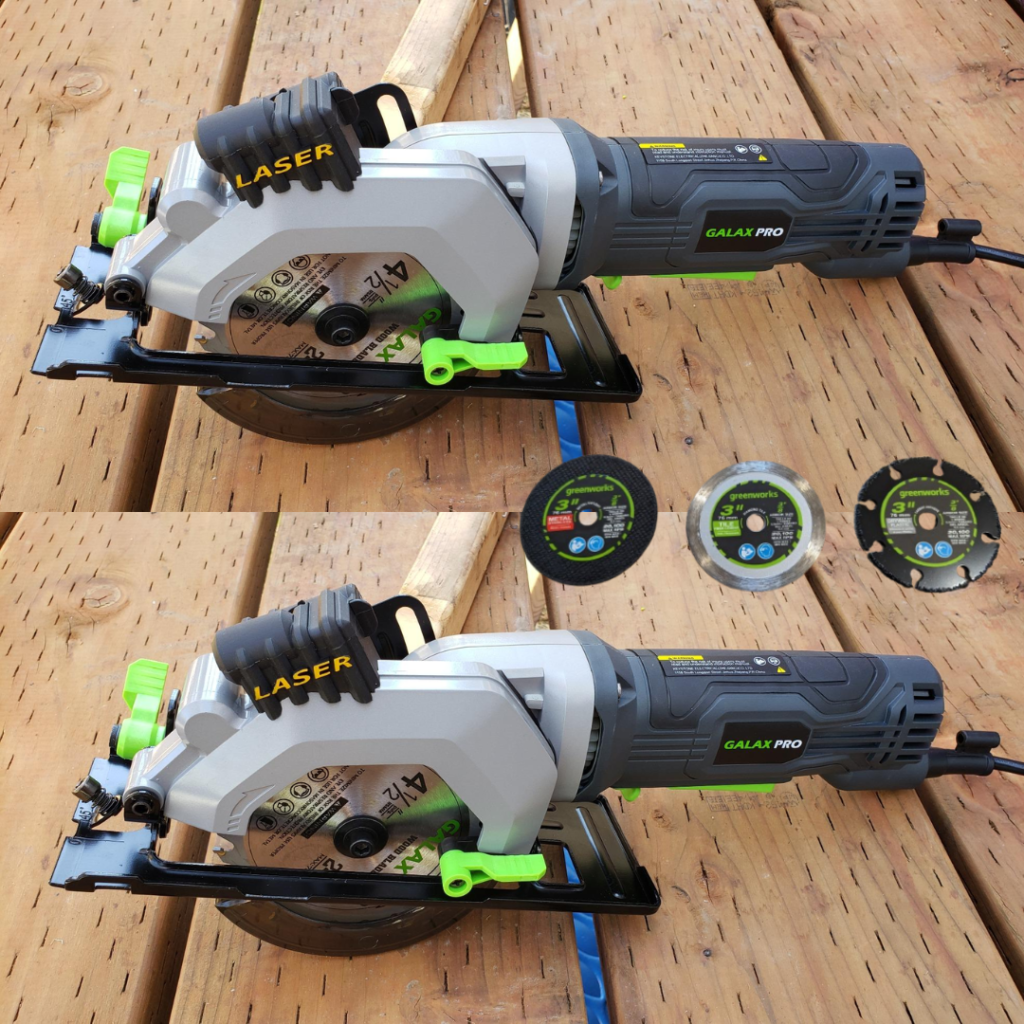You often produce a wobbly outcome when you attempt to cut a straight line using a circular saw. It happens! Selecting a clean, straight line with a circular saw proves to be easier than most people realize. Using several straightforward techniques transforms the cutting outcomes for cordless circular, round, and metal circular saws. You have been in the same situation, but I discovered straightforward solutions for correction. In this guide, I’ll provide step-by-step instructions on how to make a straight cut with a circular saw. Let’s dive in—you’ll be cutting straight in no time!

Choosing the Right Circular Saw
Various circular saws exist in the market. Your selection of circular saw will depend on the project nature materials used alongside your estimated usage frequency. We will simplify matters by examining the different choices. How To Make Straight Cut With Circular Saw.
Cordless vs. Corded Circular Saws: Pros and Cons
A cordless circular saw lets you move freely without worrying about a cord. It’s great for quick jobs and works well in places without power. But the downside? The battery can run out fast, especially on big projects. How To Make Straight Cut With Circular Saw.
A corded circular saw gives you steady power, so you can cut as long as you need. It’s great for tough jobs, but you’ll need an outlet and have to manage the cord.
Round Saw vs. Metal Circular Saw: Which One to Use?
A round saw (another name for a regular circular saw) is best for cutting wood. Most people use it for plywood, framing, and general carpentry.
A metal circular saw is made for cutting metal. Its special blade handles steel, aluminum, and more. Using a wood-cutting saw on metal can ruin the blade or damage the saw.
Best Rated Circular Saws: What to Look For
When choosing the best-rated circular saw, look for these key features:
Look for appliances with at least 15 amps when using a connected power source or choose products using powerful cordless batteries. How To Make Straight Cut With Circular Saw.
Blade Size- A 7-1/4-inch blade works for most projects.
Bevel Adjustment- This lets you cut angles easily.
Dust Blower- Clears sawdust so you can see your line.
Electric Brake- Stops the blade quickly for safety.
What Is the Best Skil Saw?
Ever wonder, What is the best Skil saw? Skil is a well-known brand that makes both beginner—and pro-level saws. One top pick is the Skilsaw SPT77WML-01, a lightweight worm drive saw that cuts smoothly and accurately.
Essential Tools and Materials
Prior to making a straight cut the correct tools will substantially improve your results. A strategic setup both safeguards your person and reduces errors while saving work time. Here’s what you need.
Circular Saw (Corded or Cordless)
The main tool for the operation is a circular saw. Users can benefit from steady power delivery through corded saws for extensive cutting but achieve freedom of movement with cordless saws.
Saw Blade Selection (Wood, Metal, etc.)
Not all blades are the same. A wood blade works best for plywood and lumber, while a metal blade is steel or aluminum. Using the wrong blade can ruin your saw or cut. How To Make Straight Cut With Circular Saw.
Guide Rail or Straight Edge
The guide rail functions to keep your saw on track for achieving accurate results from your woodworking operations. The guide rail can originate from an available purchase or you can create your own with straight clamps and an edge. The guide rail creates the most effective method to prevent wavy cuts from forming. How To Make Straight Cut With Circular Saw.
Clamps
Clamps stop your material from moving while you cut. Even a small shift can mess up your line.
Measuring Tape and Pencil
A measuring tape ensures you cut the right length. A pencil marks a clear line to follow.
Safety Gear (Gloves, Goggles, Dust Mask)
Safety first! Protecting your hands requires gloves while goggles defend your eyes from dust and wearing a dust mask stops you from inhaling sawdust.

Step-by-Step Guide to Making a Straight Cut
Cutting a straight line with a circular saw can feel tricky. You start strong, but then—whoops!—the cut wobbles. The good news? It doesn’t have to be that way. A few simple tricks can help you cut like a pro.
A. Marking and Measuring Accurately
A straight cut starts with good measuring. If your line is off, your cut will be too.
- Use a straight edge – A speed square or a longboard works great.
- Double-check your marks – Measure twice and cut once. Mistakes waste wood!
- Make clear lines – Use a pencil or chalk to see where to cut.
B. Using a Guide for Precision
A guide helps you stay on track. No more wandering cuts!
- Use a straight edge or guide rail – It keeps the saw moving in a straight line.
- DIY vs. store-bought guides are great, but a board and clamps work, too.
- Clamp it tight – If it moves, your cut will, too. Lock it in place before cutting.
C. Setting Up the Circular Saw
A saw that’s not set right can ruin your cut. Fix it before you start.
- Set the blade depth – It should be just past the wood, not too deep.
- Check the angle. Do you want a straight cut? Make sure the bevel is at 0°.
- Align before cutting – Place the blade on your mark before pulling the trigger.
D. Making the Cut
Now it’s time to cut! Stay steady, and don’t rush.
- Stand firm – Keep your feet planted so you feel balanced.
- Grip the saw well – One hand on the handle, the other steadying the front.
- Move smoothly – Let the saw do the work. No pushing!
- Keep the base flat – If the saw tilts, your cut won’t be straight.
E. Finishing Touches
A little cleanup makes your cut look better.
- Check your cut – Use a square to see if it’s perfectly straight.
- Sand the edges – If they feel rough, smooth them out with sandpaper.
Common Mistakes and How to Avoid Them
Cutting straight with a circular saw sounds easy, but small mistakes can ruin a project. I’ve had my fair share of wobbly cuts—trust me, it’s frustrating! The good news? Fixing these issues is simple.
1. Pushing Too Fast or Too Slow
If you rush, the saw might bind or jump. Go too slow, and the wood could burn.
2. Not Securing the Workpiece
If your wood moves, your cut won’t stay straight. Even a tiny shift can throw you off.
3. Using the Wrong or a Dull Blade
A dull blade makes cutting hard. The wrong blade? Even worse—it can tear the material.
FAQs (Optimized for Voice Search & Snippets)
How do I cut straight without a guide?
It’s not as hard as it seems! Keep the saw steady and follow your line. Focus on the blade, not the base. Move at a smooth, even pace. If you wobble, pause, reset, and go again. But honestly? A guide makes it way easier!
What is the best circular saw for beginners?
Go for a light and easy-to-use saw. The Skil 5280-01 is great—it’s simple and cuts well. If you want cordless, try the Makita XSS02Z. Pick one that feels right in your hands!
Can a metal circular saw cut wood?
It can, but you shouldn’t do it! Metal saws run slower and have the wrong blade. This can cause rough cuts or damage to the saw. A wood-cutting circular saw is the better choice!
Why does my circular saw cut at an angle?
Your blade might be tilted. Could you set it to 0° for a straight cut? Also, press the saw base flat on the wood. If the saw tilts while cutting, the angle will be off. A guide can help!
How do I keep my cuts smooth and splinter-free?
Use a sharp, fine-tooth blade for clean cuts. Cut with the good side facing down since the saws are cut upwards. For plywood, tape the cut line first—it helps prevent splinters!
Conclusion: Easy Straight Cuts
Cutting straight with a circular saw is simple! Measure well, use a guide, and let the saw move smoothly. There is no need to push too hard.
Think of it like drawing a straight line with a ruler. At first, it takes focus, but soon, it feels natural. The more you practice, the better you get!

Hi, I’m Tom Scalisi, and welcome to The Saw Blog! I started this blog to share my hands-on experience and insights about woodworking tools—especially saws and saw blades. Over the years, I’ve had the chance to work with a wide range of tools, and I’m here to help both professionals and hobbyists make informed decisions when it comes to selecting and using their equipment. Whether you’re looking for in-depth reviews, tips, or just advice on how to get the best performance out of your tools, you’ll find it here. I’m excited to be part of your woodworking journey!
